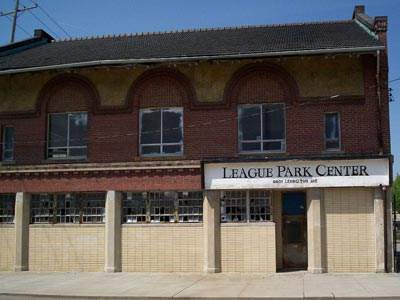I am not sure what brought me here. It isn't as if I have cherished memories to relive, for I never saw a game within its confines. But there is a spirit here. A spirit which draws one closer and closer and demands all kinds of answers as to what was and what might-have been.
They tore down League Park, you know. I just want to know why.
I guess I really didn't know what to expect when I decided to go see what was left of League Park, once the home of Cleveland's professional baseball teams for all or parts of seasons from 1891 to 1946. Articles I'd read in Cleveland newspapers led me to believe there wouldn't be much to see. And they were right.
Where once the legends of baseball had graced this lot . . . Ruth . . . Gehrig . . . Foxx . . . Johnson . . . Cobb . . . Speaker . . . LaJoie . . . now stands the battered remains of a ballpark and its memories. Those remains consist of only a chunk of the grandstand along East 66th Street.
The crumbling, decayed concrete which stands behind what used to be the first base line, and under which was located the Cleveland clubhouse, now provides shelter for rats and trash.

Broken glass and old tires litter what used to be a beautiful baseball diamond. The excess of graffiti and garbage render this historical landmark just another ghetto playground. I just want to know why.
They say that this was a beautiful park once. A bright, red brick frame complete with double deck grandstands which, according to former Cleveland Press writer, Frank Gibbons, "swept down the foul lines like great wings," and was so intimate that fans could "hear the cussing of their heroes and, sometimes, feel the tobacco spray."
It is said that fans in the upper deck could bellow their demands, insults, and pleas and still be heard by the players no matter the size of the crowds. Fans were so close, in fact, that incidents between players and fans were not uncommon in those early, years.
On one occasion, Cleveland player Jeff Heath was close enough to punch a heckler above the clubhouse runway. Then there's the story of the great Joe McCarthy, who managed those fabulous Yankee teams of the early 1900s.
Apparently, a fan seated behind the third base dugout had been on McCarthy's case all day: "fathead" and "idiot" were the mildest adjectives he directed McCarthy's way.
With poise and dignity, McCarthy withstood the brunt of the abuse. Finally, it reached a peak. After removing his pitcher, McCarthy paraded back to the dugout, whereupon he was greeted with still more ill-treatment.
McCarthy proceeded to gaze straight at the fan, pulled his hat down over his eyes, and yelled, "Kiss my Irish foot," to the delighted and, soon to be, laughing crowd.
Then there were the press boxes. Equipped with telegraph services and affiliated cacophony, the writers were in a constant state of peril. Foul balls regularly whizzed into the windowless boxes.
Alongside the writers for many years sat Cleveland broadcaster Jack Graney, said to be so adept that he could actually recreate away games from the wire reports at his Cleveland studio without listeners suspecting a thing.
League Park was unique. Unlike the many faceless, concrete-laden, geometrically perfect superstructures which passed off for ballparks in the '60's, '70's, and '80's, League Park had personality.
It can be argued that League Park's architecture, and that of a number of its contemporaries of that time (Forbes Field, Crosley Field, Sportsman's Park, Fenway Park, and Wrigley Field) certainly served as inspiration for the proliferation of retro-style venues that began sprouting from our national landscape in the early '90's, led by one of the most stunning---Baltimore's Oriole Park at Camden Yards.
For one thing, it possessed natural, green, honest-to-goodness grass rather than one of the several types of synthetic turf favored by many of the ballclubs in that 30-year era. And this park had no roof, no dome overhead to block out the sun, wind, and stars. Upon opening in 1891, this wooden-modeled park was described by one newspaper as "fit for kings and fans."
But someone didn't think so. I just want to know why.
The wall. It is a story in itself. Originally, there were wooden bleachers which made up the right field area along Lexington Avenue. These stands were soon moved to center, though, and a 40-foot wall and screen became the feature of the new park. The wall eventually became an integral contributor in the unfolding of many games and it had the power to make or break a team.
While the left and center fielders had plenty of room to judge and make splendid catches, saving many a pitcher from an early shower, the right fielders were not so fortunate. They had little time to decide whether to make an attempt to catch the ball or play it off the wall.
If one did try to catch the ball, he might have found it too high to catch and the ball would bound back toward the infield. Then again, if he played it safe and waited for the ball to hit the wall, he found that many times he could have caught it in the first place.
The wall's grasp did not end there. Sometimes, a well-hit line drive would find its flight halted in mid-air by the screen extension on top of the wall -- a possible home run in another park.
Once a ball hit the screen, three things could happen: the ball could rebound honestly, it could stick in the screen, or it could fall straight to the ground as if dropped from an airplane. You could never tell.
Today, a rust-tinted steel fence of about 10 feet stands in its place. That's progress, I guess.

